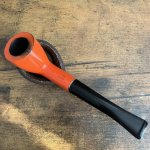A while back I started a topic looking for recommendations on a painted briar. Nearly once a day I find myself cleaning stalls and spraying the horses with fly spray.
This daily chore is also one of daily smoke times. We use an oil based pyrethrin that is stinky and quite nasty. Don’t bother with the admonitions that I shouldn’t be smoking while applying pesticides, I’m a certified applicator by AZ Dept of Ag, so I know I shouldn’t, but I do anyway (Danger is my middle name, baby!).
When I know I’m going to be spraying, I usually grab my White Briar Belgique, as its exterior won’t absorb the nasty overspray if I catch a cloud of it but I was looking for a little larger bowled pipe that was similar.
Earlier this week I was surprised by a box in my mail drop from an absolutely awesome forum friend, and in it was a Dr Grabow Color Duke he’d had in the “clean up someday” bin and gifted it my way (you rock Jeff!).
After a cursory wipe down, it looked pretty good: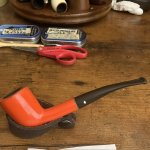
There was quite a bit of dentition, and as I started what I thought would be a routine micromesh/mineral oil cleanup of the stem I realized the vulcanite’s oxidation was pervasive and deep, and there were more issues than first apparent.
I cleaned the airway with Everclear on brushes, qtips, bristled cleaners til the tars and gunk were gone.
Then the stem’s exterior got a flame treatment to raise any teeth marks that would respond, and a good wipe with Everclear and on to a bath in warm tap water and brushed down and let dry.
This exposed the true nature of the stink hiding in the rubber, and a crack near the button that was passing air (and almost light).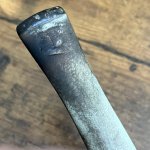
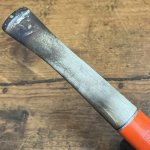
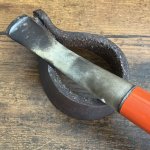
I gave the stem the full treatment that @georged teaches so well in his outstanding videos. I cannot thank him enough for sharing his wisdom and methods gleaned though years of experience. He is one among many of you that have flattened my learning curve.
I’m a guy that is interested in making my old tools functional again, and doing what I can to enjoy my stuff-I’m not interested in becoming a professional restoration source. I’m happy to farm out jobs of real complexity to get something I really want done, and have commissioned stem work that will cost 150% of what I have in a pipe, but that’s wholly driven by improving function and my enjoyment of a stummel I really want to go smoke in the course of my days.
Anyway, if you watch the videos I referenced, I did all the sanding work as shown, then addressed the problems.
Since this will ultimately be a beater pipe that will see hard use, I skipped getting the G Flex black glue (I do need to get some someday) and after sanding as much as I thought prudent I used regular Gorilla Gel CA glue to fill the crack and bad tooth marks. The crack got two treatments as I applied vacuum on the first to drew the CA into into the crack (carefully, and I’m happy to report I didn’t glue the button to my lip in doing so ).
).
After the repairs had cured, the sanding steps were repeated on the affected area.
At that point I departed from George’s methods since I don’t have a buffer, and got after it with micromesh pads (alá RebornPipes) until I got where I was happy with it.
The chamber was flat bladed with a curved blade on an old jackknife that I love for this purpose, and the chamber and shank’s filter and hardware area got an Everclear/salt treatment.
Stem and stummel got an overnight coating of Howard’s Butcher Block Conditioner, then buffed up with a microfiber towel.
Full collector grade restoration? Hardly.
Good enough for me to enjoy the heck out it for many years of hard use? Oh heck yeah!
Thanks to all those that make this stuff possible and enjoyable!
It takes a village to raise an idiot!
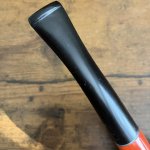
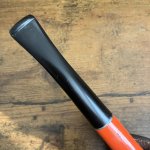
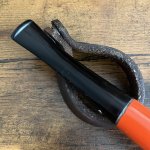
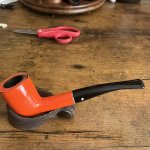
You’ll be seeing the other side soon in plenty of action shots in the WAYS threads.
This daily chore is also one of daily smoke times. We use an oil based pyrethrin that is stinky and quite nasty. Don’t bother with the admonitions that I shouldn’t be smoking while applying pesticides, I’m a certified applicator by AZ Dept of Ag, so I know I shouldn’t, but I do anyway (Danger is my middle name, baby!).
When I know I’m going to be spraying, I usually grab my White Briar Belgique, as its exterior won’t absorb the nasty overspray if I catch a cloud of it but I was looking for a little larger bowled pipe that was similar.
Earlier this week I was surprised by a box in my mail drop from an absolutely awesome forum friend, and in it was a Dr Grabow Color Duke he’d had in the “clean up someday” bin and gifted it my way (you rock Jeff!).
After a cursory wipe down, it looked pretty good:

There was quite a bit of dentition, and as I started what I thought would be a routine micromesh/mineral oil cleanup of the stem I realized the vulcanite’s oxidation was pervasive and deep, and there were more issues than first apparent.
I cleaned the airway with Everclear on brushes, qtips, bristled cleaners til the tars and gunk were gone.
Then the stem’s exterior got a flame treatment to raise any teeth marks that would respond, and a good wipe with Everclear and on to a bath in warm tap water and brushed down and let dry.
This exposed the true nature of the stink hiding in the rubber, and a crack near the button that was passing air (and almost light).



I gave the stem the full treatment that @georged teaches so well in his outstanding videos. I cannot thank him enough for sharing his wisdom and methods gleaned though years of experience. He is one among many of you that have flattened my learning curve.
I’m a guy that is interested in making my old tools functional again, and doing what I can to enjoy my stuff-I’m not interested in becoming a professional restoration source. I’m happy to farm out jobs of real complexity to get something I really want done, and have commissioned stem work that will cost 150% of what I have in a pipe, but that’s wholly driven by improving function and my enjoyment of a stummel I really want to go smoke in the course of my days.
Anyway, if you watch the videos I referenced, I did all the sanding work as shown, then addressed the problems.
Since this will ultimately be a beater pipe that will see hard use, I skipped getting the G Flex black glue (I do need to get some someday) and after sanding as much as I thought prudent I used regular Gorilla Gel CA glue to fill the crack and bad tooth marks. The crack got two treatments as I applied vacuum on the first to drew the CA into into the crack (carefully, and I’m happy to report I didn’t glue the button to my lip in doing so
After the repairs had cured, the sanding steps were repeated on the affected area.
At that point I departed from George’s methods since I don’t have a buffer, and got after it with micromesh pads (alá RebornPipes) until I got where I was happy with it.
The chamber was flat bladed with a curved blade on an old jackknife that I love for this purpose, and the chamber and shank’s filter and hardware area got an Everclear/salt treatment.
Stem and stummel got an overnight coating of Howard’s Butcher Block Conditioner, then buffed up with a microfiber towel.
Full collector grade restoration? Hardly.
Good enough for me to enjoy the heck out it for many years of hard use? Oh heck yeah!
Thanks to all those that make this stuff possible and enjoyable!
It takes a village to raise an idiot!




You’ll be seeing the other side soon in plenty of action shots in the WAYS threads.
Attachments
Last edited:







